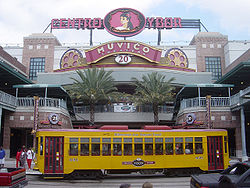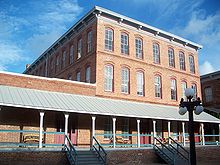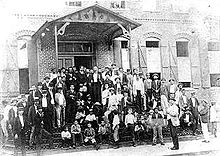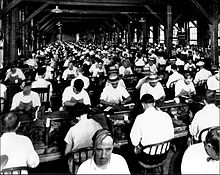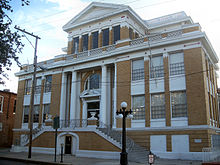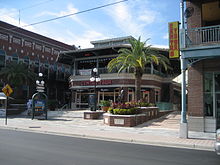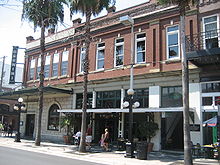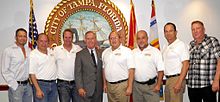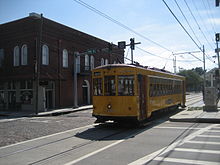- Ybor City
-
Ybor City — Neighborhood — Centro Ybor complex with a TECO Line car passing in front Nickname(s): Florida's Latin Quarter Coordinates: 27°57′41″N 82°26′42″W / 27.96139°N 82.445°WCoordinates: 27°57′41″N 82°26′42″W / 27.96139°N 82.445°W Country United States State Florida County Hillsborough County City Tampa Founded 1885 Incorporation into Tampa 1887 Time zone EST (UTC-5) - Summer (DST) EDT (UTC-4) Website http://www.yboronline.com/ - This article is about the historic neighborhood in Tampa, Florida, USA. For the cigar manufacturer for which it was named, see Vicente Martinez Ybor.
Ybor City (
 /ˈiːbɔr/ ee-bor) is a historic neighborhood in Tampa, Florida located just northeast of downtown. It was founded in the 1880s by cigar manufacturers and was populated by thousands of immigrants, mainly from Spain, Cuba, and Italy. For the next 50 years, workers in Ybor City's cigar factories would roll millions of cigars annually.
/ˈiːbɔr/ ee-bor) is a historic neighborhood in Tampa, Florida located just northeast of downtown. It was founded in the 1880s by cigar manufacturers and was populated by thousands of immigrants, mainly from Spain, Cuba, and Italy. For the next 50 years, workers in Ybor City's cigar factories would roll millions of cigars annually.The neighborhood had features unusual among contemporary immigrant communities in the southern United States, most notably its multi-ethnic and multi-racial population and their many mutual aid societies.[1] A slow exodus out of the area that began during the Great Depression accelerated after World War II, leading to a period of abandonment and decay. After decades of neglect, a portion of the original neighborhood has redeveloped into a night club and entertainment district. One of the five campuses of Hillsborough Community College is located there - HCC Ybor.
The neighborhood has been designated as a National Historic Landmark District, and several structures in the area are listed in the National Register of Historic Places. In 2008, 7th Avenue, the main commercial thoroughfare in Ybor City, was recognized as one of the “10 Great Streets in America” by the American Planning Association.[2] In 2010 Columbia Restaurant was named a "Top 50 All-American icon" by Nation's Restaurant News magazine.[2]
Contents
History
Main article: History of Ybor CityEstablishment
In the early 1880s, Tampa was an isolated village with a population of less than 1000 and a struggling economy.[3] However, its combination of a good port, Henry Plant’s new railroad line, and humid climate attracted the attention of Vicente Martinez Ybor, a prominent Spanish-born cigar manufacturer.[4]
Ybor had moved his cigar-making operation from Cuba to Key West, Florida in 1869, due to political turmoil in the then-Spanish colony. But, labor unrest and the lack of room for expansion had him looking for another base of operations, preferably in his own company town.[5]
Ybor considered several communities in the southern United States and decided that an area of sandy scrubland just northeast of Tampa would be the best location. In 1885, the Tampa Board of Trade helped broker an initial purchase of 40 acres (160,000 m2) of land, and Ybor quickly bought more.[5]
Cigar making was a specialized trade, and Tampa did not possess a workforce able to man the new factories. To attract employees, Ybor built hundreds of small houses for the coming influx of mainly Cuban and Spanish cigar workers, many of whom followed him from Key West and Cuba. Other cigar manufacturers, drawn by incentives provided by Ybor to further increase the labor pool, also moved in, quickly making Tampa a major cigar production center.[6]
Italians were also among the early settlers of Ybor City. Most of them came from a few villages in southwestern Sicily. The villages were Santo Stefano Quisquina,[7] Alessandria della Rocca, Bivona, Cianciana, and Contessa Entellina.[8] Sixty percent of them came from Santo Stefano Quisquina.[9] Before settling in Ybor City, many first worked in the sugar cane plantations in St. Cloud, central Florida. Some came by way of Louisiana.[10] A number of families migrated from New Orleans after the lynching of eleven Italians in 1891 during the “Mafia Riot.”[11] Italians mostly brought their entire families with them, unlike other immigrants.[11] The foreign-born Italian population of Tampa grew from 56 in 1890 to 2,684 in 1940.[12] Once arriving in Ybor City, Italians settled mainly in the eastern and southern fringes of the city. The area was referred to as La Pachata, after a Cuban rent collector in that area. It was also called “Little Italy.”[12]
Unlike Cubans and Spaniards, the Italians arrived in the cigar town without cigar-making skills. When the early Italians entered the factories, it was at the bottom of the ladder, positions which did not involve handling tobacco. Working beside unskilled Cubans, mainly Afro-Cubans, they swept and hauled, and were porters and doorkeepers. In time, many did become cigar workers, including Italian women. The majority of the Italian women worked as cigar strippers in 1900, an undesirable position mainly held by women who could find nothing else. However, eventually many of them became skilled cigar makers, earning more than the male Italian cigar makers. Other Italian immigrants started small businesses built around the cigar industry, such as cafés, food stores, restaurants, and boardinghouses.
The least known of the immigrants that came to Ybor City are the Germans,[13] the Romanian Jews, and the Chinese. The Chinese and Jews were employed mainly in service trades and retail businesses.[14] The Germans arrived after the 1890s, and most were businessmen. In the cigar factories, they worked as managers, bookkeepers, and supervisors. Cigar boxes were made by German-owned factories. Several early cigar box labels were made by German lithographers. The Germans formed their own club, the Deutche Amerikanscher Verein. The club building is still standing on Nebraska and 11th Avenue. It contained a restaurant open to the public that served German food. In 1919, because of anti-German feelings from World War I, they sold the building to the Young Men’s Hebrew Association. The building is now used as offices for the City of Tampa.[15]
In 1887, Tampa annexed the neighborhood. By 1900, the rough frontier settlement of wooden buildings and sandy streets had been transformed into a bustling town with brick buildings and streets, a streetcar line, and many social and cultural opportunities. Largely due to the growth of Ybor City, Tampa’s population had jumped to almost 16,000.[16]
The Golden age
Ybor City grew and prospered during the first decades of the 20th Century. Thousands of residents built a community that combined Cuban, Spanish, Italian, and Jewish culture. “Ybor City is Tampa’s Spanish India,” observed a visitor to the area, “What a colorful, screaming, shrill, and turbulent world.” [17]
An aspect of life were the mutual aid societies built and sustained mainly by ordinary citizens. These clubs were founded in Ybor's early days (the first was the Centro Español, established in 1891) and were run on dues collected from their members, usually 5% of a member's salary. In exchange, members and their whole family received services including free libraries, educational programs, sports teams, restaurants, numerous social functions like dances and picnics, and free medical services. Beyond the services, these clubs served as extended families and communal gathering places for generations of Ybor's citizens.
There were clubs for each ethnic division in the community – the Deutscher-Americaner Club (for German and eastern Europeans), L’Unione Italiana (for Italians), El Circulo Cubano (for light-skinned Cubans), La Union Marti-Maceo (for darker-skinned Cubans), El Centro Español (for Spaniards), and the largest, El Centro Asturiano, which accepted members from any ethnic group[18]
Although there was little racism in Ybor City, Tampa's Jim Crow laws at the time forbade Afro-Cubans from belonging to the same social organization as their lighter-skinned countrymen. Sometimes, differences in skin color within the same family made joining the same Cuban club impossible.[19] In general, the rivalries between all the clubs were friendly, and families were known to switch affiliations depending on which one offered preferred services and events.
Cigar production reached its peak in 1929, when 500,000,000 cigars were rolled in the factories of Ybor City.[20] Not coincidentally, that was also the year that the Great Depression began.
Decline and rebirth
The Depression was a major blow to cigar manufacturers. Worldwide demand plummeted as consumers sought to cut costs by switching to less-expensive cigarettes, and factories responded by laying off workers or shutting down. This trend continued throughout the 1930s as the remaining cigar factories gradually switched from traditional hand-rolled manufacturing to cheaper mechanized methods, further reducing the number of jobs and the salaries paid to workers.[21]
After the World War II, many returning veterans chose to leave Ybor City due to a lack of well-paying jobs and a US Veterans Administration home loan program that was only applicable to new homes, of which there were few in the neighborhood. In fact, the home stock was aging poorly, as many of the structures built in the early days of Ybor City were still in use.[22]
As the historic neighborhood continued to empty out and deteriorate through the 1950s and 1960s, the federal Urban Renewal program sought to revitalize the area by demolishing older structures and encouraging new residential and commercial development. The demolition took place, but due to a lack of funds, the redevelopment did not happen. The primary legacy of the program were blocks of vacant lots which would remain empty for decades. The construction of Interstate 4 through the center of the neighborhood during this period also resulted in the destruction of many buildings and cut most of the north-south routes through the area.[21]
By the early 1970s, very few businesses and residents remained, most notably the Columbia Restaurant and a few other businesses along 7th Avenue.[23]
Recovery
In the early 1980s, an influx of artists seeking interesting and inexpensive studio quarters started a slow recovery, followed by a period of commercial gentrification.[24][25] By the early 1990s, many of the old long-empty brick buildings on 7th Avenue had been converted into bars, restaurants, nightclubs, and other nightlife attractions.[26] Traffic grew so much that the city built parking garages and closed 7th Ave. to traffic to deal with the visitors.
Since around 2000, the city of Tampa and the Ybor City Chamber of Commerce have encouraged a broader emphasis in development. With financial help from the city, Centro Ybor, a family-oriented shopping complex and movie theater, opened in the former home of the Centro Español social club. New apartments, condominiums and a hotel have been built on long-vacant lots, and old buildings have been restored and converted into residences and hotels. New residents began moving into Ybor City for the first time in many years.[27] The blocks surrounding 7th Avenue also thrive with restaurants, nightlife and shopping.[3][4] Reflecting the district's status as a party destination, Ybor City is referenced extensively in the lyrics of Brooklyn-based rock band The Hold Steady. The song "Killer Parties," for instance, contains the line "Ybor City is très speedy, but they throw such killer parties."[28] In May 2009 Swedish super-retailer IKEA opened its long-awaited Tampa location in the southern edge of Ybor City.[29]
GaYbor
Main article: GaYborIn late 2007, business organization and district GaYbor was formed. The area is centered around 7th Ave. and 16th St., featuring many LGBT-friendly establishments. Every July the district has a street party called "GaYbor Days." [30] The organization is sponsoring a public art display of painted pianos to be scattered around Historic Ybor.[31]
Boundaries
Historically, the boundaries of “Greater Ybor City” stretched from Tampa Bay on the south to Dr. Martin Luther King Jr. Blvd. (formerly Buffalo Avenue) on the north, and from the Hillsborough River on the west to 40th Street on the east.[20] This would include all of today’s neighborhoods of Historic Ybor, East Ybor, VM Ybor, and Ybor Heights plus a portion of East Tampa. The Ybor City Historic District encompasses the central portion of that area, approximately straddling Interstate 4, which bisected the neighborhood in the 1960s.[32]
The official boundaries of the Historic Ybor neighborhood are I-4 to the north, 22nd Street to the east, Adamo Drive to the south, and Nebraska Avenue to the west.[33] The area of this district is about 1 square mile (about 2.6 km2). Though modern Ybor City also includes some of the surrounding area, its exact dimensions are loosely defined and subject to debate.[34]
Population
At the height of its life as a thriving immigrant community, Ybor City’s population was numbered in the tens of thousands. In the lowest point in the late 1970s, perhaps 1000 residents called the neighborhood home.[20]
In recent years, the numbers have begun to climb once more. Ybor City’s population grew an estimated 42.5% between 2000 and 2003, mainly as a result of new condominium and apartment construction. As of 2003, approximately 2,900 residents lived in the area.[27]
Economy and land use
Ybor City is one of the oldest sections of Tampa and is almost entirely an urban, built-up area. Commercial property comprises almost 50% of the land, institutional use (including the Hillsborough County Sheriff’s Operations Center and a satellite campus of Hillsborough Community College) 16%, residential use about 23%, and industrial use about 7% [35]
According to a 2003 survey, the top five business types in the area were professional services (22.8%), retail (18.4%), manufacturing (14.0%), wholesale/distribution (13.2%), and restaurants & bars (11.4%).[27]
Transportation
For the most part, Ybor City still uses the gridded street system laid out by Gavino Guiterrez in 1885. Many roadways are now paved with modern materials, though a few brick streets remain.
Because 21st and 22nd Streets, which cut north-south through the area, are the main traffic routes between Interstate 4 and the Port of Tampa, there is a large volume of truck traffic funneling through the historic district, causing damage to narrow city roads and sometimes colliding with historic buildings.[36] Work on an elevated connector between I-4 and the Lee Roy Selmon Expressway to siphon truck traffic away from the area began in January 2010. The project is scheduled to be complete in 2014.[37]
Public transit
The TECO Line Streetcar System, which links Ybor City, the Channelside District and Downtown Tampa, began operating in October 2002. The Hillsborough Area Regional Transit Authority (HARTline) operates the streetcars as well as the bus system. Small startups have also begun utilizing NEVs to shuttle passengers between Tampa's core neighborhoods including Ybor.[38]
Museums
- Cigar Museum And Visitor Center, Ybor City
- Ybor City Museum State Park
- TECO Line Streetcar Museum
Annual events
- Sant'Yago Knight Parade (also known as Gasparilla Night Parade) - usually held the Saturday following the Gasparilla Pirate Festival in late February
- Guavaween - daytime events and nighttime parade in October, named for Tampa's "Big Guava" nickname
- Rough Rider's St. Patrick's Night Parade - illuminated nighttime parade held on or near St. Patrick's Day, mid-March
- Tampa Cigar Heritage Festival - celebrated mid-November
- Festa Italiana Weekend event celebrating Italian culture and food, celebrated mid-April
- Fiesta - weekend event celebrating Latin culture and food, celebrated mid-February
- GaYbor Days - four-day long street festival in the GaYbor district, held in July
- Cigar City Tattoo Convention - annual tattoo convention hosted at the Historic Cuban Club
Notable natives of Ybor City
Al Lopez, baseball hall of famer
Ferdie Pacheco, boxing personality, artist, and author
Jose Yglesias, author
Nick Nuccio, first Italian Mayor of Tampa
Dick Greco, former multi-term mayor of Tampa
Braulio Alonso, first Hispanic president of the National Education Association
Santo Trafficante, Jr., (alleged) Mafia boss
Frank Ragano, "mob lawyer", author
Joe Lala, musician and actor
Baldomero Lopez, Medal of Honor recipientSee also
- Channelside
- Downtown Tampa
- Hyde Park
- SoHo
- Tampa Heights, historic neighborhood bordered to the northwest
- West Tampa, historic district a few miles northwest with similar Cuban roots.
References
- ^ "National Historic Landmarks Program (NHL)". Tps.cr.nps.gov. http://tps.cr.nps.gov/nhl/detail.cfm?ResourceId=1427&ResourceType=District. Retrieved 2008-12-26.
- ^ "Historical 7th Avenue in Ybor City recognized - Tampa Bay Business Journal:". Bizjournals.com. 2008-10-08. http://www.bizjournals.com/tampabay/stories/2008/10/06/daily28.html. Retrieved 2008-12-26.
- ^ Mormino&Pizzo, Ch. 9
- ^ "Ybor City: Cigars in Ybor". Ybortimes.com. http://www.ybortimes.com/cigars.cfm. Retrieved 2008-12-26.
- ^ a b "Research | Ybor City Museum". Ybormuseum.org. http://www.ybormuseum.org/research/ybor-city.html. Retrieved 2008-12-26.[dead link]
- ^ "Park Summary for Print - Ybor City Museum State Park". Florida State Parks. 2003-12-05. http://www.floridastateparks.org/yborcity/ParkSummary.cfm. Retrieved 2010-01-18.
- ^ Gary R. Mormino and George E. Possetta, The Immigrant World of Ybor City, Italians and Their Neighbors in Tampa, 1885-1985 (Gainesville: University Press of Florida, 1998), 9.
- ^ Frank Trebín Lastra, Ybor City, The Making of A Landmark Town (Tampa, Florida: University of Tampa Press, 2006), 64.
- ^ Mormino and Possetta, The Immigrant World of Ybor City, 9.
- ^ Lasta, Ybor City, 64, 74, 73.
- ^ a b Mormino and Possetta, The Immigrant World of Ybor City, 82.
- ^ a b Mormino and Possetta, The Immigrant World of Ybor City, 55.
- ^ Mormino and Possetta, The Immigrant World of Ybor City, 99, 101, 106, 86.
- ^ National Park Service[1] "Ybor City, the Cigar Capital of the World": accessed 6 February 2010.
- ^ Lasta, Ybor City, 85-88.
- ^ Mormino&Pizzo, p. 130
- ^ Mormino&Pizzo, p. 96
- ^ Halstead, Larry (2008-06-06). "Ybor City's cultural clubs, icons of heritage in peril - Tampa Bay Business Journal:". Bizjournals.com. http://www.bizjournals.com/tampabay/stories/2008/06/09/story1.html. Retrieved 2008-12-26.
- ^ "The Afro-Cuban Community in Ybor City and Tampa, 1886-1910 | Nancy Raquel Mirabel | OAH Magazine of History". Oah.org. http://www.oah.org/pubs/magazine/africanamerican/mirabal.html. Retrieved 2008-12-26.
- ^ a b c Lastra
- ^ a b "Ybor City: Cigar Capital of the World-Reading 1". Nps.gov. http://www.nps.gov/history/nr/twhp/wwwlps/lessons/51ybor/51facts1.htm. Retrieved 2008-12-26.
- ^ "'Cigar City'". Southtampa2.tbo.com. 2008-08-31. http://southtampa2.tbo.com/content/2008/aug/31/tr-cigar-city/. Retrieved 2008-12-26.
- ^ "Florida: Ybor City Historical Site (Local Legacies: Celebrating Community Roots - Library of Congress)". Lcweb2.loc.gov. http://lcweb2.loc.gov/diglib/legacies/FL/200002851.html. Retrieved 2008-12-26.
- ^ "Jack Boulware " Archive " Cigar Overdose in Ybor City". Jackboulware.com. http://www.jackboulware.com/writing/cigar-overdose-in-ybor-city/. Retrieved 2008-12-26.
- ^ Jamison, Gayla (Producer, Director, Writer) (1987). Living in America: 100 Years of Ybor City (video documentary). Tampa, Fl: Lightfoot Films, Inc..
- ^ Seizing The Day, The Tampa Tribune, March 27, 2005.
- ^ a b c "Executive Summary" (PDF). http://www.theplanningcommission.org/tampa/tampaplanningprojects/Eco-Dev/ybor-market/Ybor%20City%20Economic%20Market%20Analysis.pdf. Retrieved 2008-12-26.
- ^ The A-to-Z Hold Steady Glossary from the Washington Post
- ^ "Ikea To Open Ybor City Store In May". .tbo.com. 2009-03-05. http://www2.tbo.com/content/2009/mar/05/ikea-open-tampa-store-may/news-metro/. Retrieved 2010-01-18.
- ^ "Hillsborough: Ybor City's rainbow of revival". Sptimes.com. 2007-10-27. http://www.sptimes.com/2007/10/27/Hillsborough/Ybor_City_s_rainbow_o.shtml. Retrieved 2010-01-18.
- ^ "Street pianos coming to Ybor | Tampa Bay, St. Petersburg, Clearwater, Sarasota | WTSP.com 10 Connects". Wtsp.com. http://www.wtsp.com/news/local/story.aspx?storyid=117172&provider=rss. Retrieved 2010-01-18.
- ^ "K:\GMDS Historic Preservation\HPC Functions\A AutoCAD Historic District Maps\Original Maps\Current District Maps\yborhist_exp 1" (PDF). http://www.tampagov.net/dept_Historic_Preservation/files/maps/yborhist_exp_12-10-01ri.pdf. Retrieved 2008-12-26.
- ^ "Historic Ybor - Maps". Tampagov.net. http://www.tampagov.net/appl_neighborhoods/default.aspx?section=boundary&id=35. Retrieved 2008-12-26.
- ^ "Citytimes: Not in Ybor City". Sptimes.com. http://www.sptimes.com/2008/01/11/Citytimes/Not_in_Ybor_City.shtml. Retrieved 2008-12-26.
- ^ http://www.tampagov.net/appl_neighborhoods/default.aspx?export=pdf§ion=landuse&id=35
- ^ "Ybor City hopes connector will ease traffic woes - St. Petersburg Times". Tampabay.com. http://www.tampabay.com/news/transportation/roads/ybor-city-hopes-connector-will-ease-traffic-woes/983097. Retrieved 2010-01-18.
- ^ "I-4 connector work to begin in January | Preview video - St. Petersburg Times". Tampabay.com. http://www.tampabay.com/news/transportation/roads/article1012106.ece. Retrieved 2010-01-18.
- ^ http://www2.tbo.com/content/2009/apr/07/agency-discuss-regulating-golf-cart--vehicles/
Bibliography
- Espinosa, Jack (2008). Cuban Bread Crumbs. Xlibris Corporation. ISBN 9781425796785.
- Tampa Bay History Center (2003). Hillsborough’s Communities. Tampa Bay History Center. ISBN 1930148070.
- Ingalls, Robert (2003). Tampa Cigar Workers: A Pictorial History. Gainesville, Fla.: University Press of Florida. ISBN 0813026024.
- Lastra, Frank (2006). Ybor City: The Making of a Landmark Town. University of Tampa Press. ISBN 159732003X.
- Mormino, Gary (1998). The Immigrant World of Ybor City. Gainesville, Fla.: University Press of Florida. ISBN 0813016304.
- Mormino, Gary; Tony Pizzo (1983). Tampa The Treasure City. Tulsa, OK: Continental Heritage Press. ISBN 0932986382.
- Muniz, Jose Rivero (translated 1976) [1954]. The Ybor City Story: 1885-1954. translated by E. Fernandez and H. Beltran. private printing.
- Pacheco, Ferdie (1994). Ybor City Chronicles. Gainesville, Fla.: University Press of Florida. ISBN 0813012961.
- Westfall, Loy G. (2000). Tampa Bay: Cradle of Cuban Liberty. Key West Cigar City USA. ISBN 966894820.
External links
- Ybor City Chamber of Commerce
- Ybor City State Museum
- Historic Ybor Neighborhood Civic Association
- Tampa Bay History Center
- Centro Asturiano Club
- The Cuban Club
- Brief history of Ybor City
- Ybor City in photographic topics
- Walking tour of Ybor City with Dr. Gary Mormino at the University of South Florida Tampa Library
- Ybor City Oral Histories at the University of South Florida Tampa Library
- La Gaceta newspaper
- TECO Line streetcar system
- “Ybor City: Cigar Capital of the World”, a National Park Service Teaching with Historic Places (TwHP) lesson plan
- University of South Florida Libraries: The Columbia Restaurant & Gonzmart Family Collection
- "Preserving the Memory of Ybor City, Florida", Southern Spaces, 22 December 2009.
Regions North Tampa | South Tampa | New Tampa
Historic Districts Hampton Terrace | Hyde Park | Seminole Heights | Tampa Heights | West Tampa | Ybor City
Central Business Districts Downtown Tampa | Uptown Tampa |
Westshore Business DistrictResidential Neighborhoods Armenia Gardens Estates | Audubon Park | Ballast Point | Bayshore Beautiful | Bayshore Gardens | Bayside West | Beach Park | Beach Park Isles | Beasley | Bel Mar Shores | Belmont Heights | Bowman Heights | Bon Air | Carver City-Lincoln Gardens | Channel District | College Hill | Courier City-Oscawana | Cory Lake Isles | Culbreath Bayou | Culbreath Isles | Davis Islands | Dixie Farms | Drew Park | Eastern Heights | East Tampa | East Ybor | Fair Oaks-Manhattan Manor | Fern Cliff | Florence Villa | Forest Hills | Gandy-Sun Bay South | Golf View | Grant Park | Gray Gables | Harbour Island | Harvey Heights | Highland Pines | Historic Hyde Park North | Hunters Green | Interbay | Jackson Heights | Live Oaks Square | Lowry Park | Lowry Park North | MacDill Air Force Base | Macfarlane Park | Marina Club | Maryland Manor | New Suburb Beautiful | North Bon Air | Northeast Community | Northeast Macfarlane | North Hyde Park | North Tampa | Northview Hills | Oakford Park | Oak Park | Old Seminole Heights | Old West Tampa | Palma Ceia | Palma Ceia West | Palmetto Beach | Parkland Estates | Port Tampa | Rattlesnake | Rembrandt Gardens | Ridgewood Park | Riverbend | Rivercrest | River Grove | Riverside Heights | Robles Park | South Seminole Heights | Southeast Seminole Heights | Southern Pines | South Nebraska | South Westshore | Stoney Point | Sulphur Springs | Sunset Park | Swann Estates | Tampa Overlook | Tampa Palms | Temple Crest | Terrace Park | University Square | V.M. Ybor | Virginia Park | Wellswood | West Meadows | Westshore Palms | West Hyde Park | West Riverfront | West Tampa | Woodland Terrace
Industrial areas Garrison Channel | Gary | Uceta Yard
Other areas Rocky Point | Soho District
Tampa Bay Area Topics Tampa Bay · Climate · History · Media · Sports · Tampa International Airport · Hillsborough County Schools · Pinellas County Schools · University of South Florida
Central cities Smaller communities Pinellas Park · Temple Terrace · Brandon · Zeyphrhills · Plant City · Largo · Dunedin · Tarpon Springs · Lutz · Greater Sun CenterCities in wider region Counties in MSA Counties in wider region Region Outlying regions Southwest Florida · Florida Heartland · Big Bend ·
Fun CoastSee also:  FloridaCategories:
FloridaCategories:- Neighborhoods in Tampa, Florida
- History of Tampa, Florida
- Cigars
- Visitor attractions in Tampa, Florida
- Company towns in Florida
- National Register of Historic Places in Hillsborough County, Florida
- Populated places established in 1885
- National Historic Landmarks in Florida
Wikimedia Foundation. 2010.

